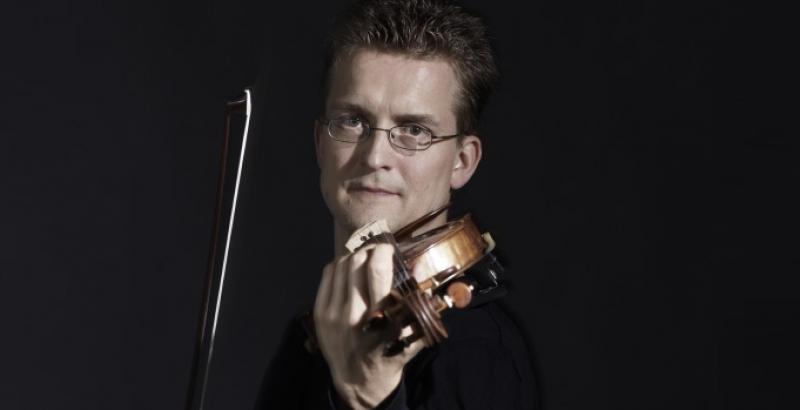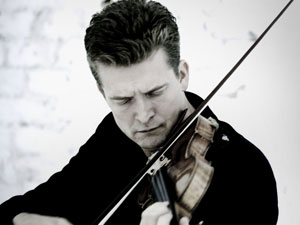Tetzlaff, Wigmore Hall | reviews, news & interviews
Tetzlaff, Wigmore Hall
Tetzlaff, Wigmore Hall
Bach without attitude but with bags of personality from this magnificent violinist

When you hear Christian Tetzlaff play you hear Brahms, or Beethoven or, in this case, Bach. What you don’t hear a lot of is Tetzlaff himself. I mean that in the best possible way – so willing is the violinist to submerge himself, to set aside ego and agenda.
It has been almost 20 years since Tetzlaff first recorded Bach’s complete music for solo violin (there’s also a 2005 recording) and since then he has gained noticeable weight to his sound. The top line, an unbroken horizon, is still effortlessly and sweetly dominant, but underneath Bach’s harmonic musculature has gained tone and heft. The range of textures available to him is greater than ever, and while the softer gestures are perhaps the more intriguing it is a delight to hear him set the Wigmore’s dome ringing with the resonance of his full force.
The A minor Allegro was a cascading, pirouetting release of nervous energy, dodging cross-rhythms on all sides
The speeds however have remained broadly the same. Only a musician as technically and idiomatically accomplished as Tetzlaff could save the Allegro from the A minor Sonata or the Corrente from the D minor Partita from feeling snatched at the pace he takes them – Corrente (from the French courir – “to run”) becomes rather literal in his hands. Yet his ear, alive to the clarity of counterpoint and never sacrificing the dance for salon virtuosity, somehow sees him through.
At times this risk becomes ecstatic. The Preludio that opens the Partita in E needed this urgency to shake off the still-looming shadow of the mighty D minor Ciaccona, and the A minor Allegro was a cascading, pirouetting release of nervous energy, dodging cross-rhythms on all sides. But for my money the Giga from the D minor Partita risked much more technically for a much smaller musical pay-off.
 Among all the semiquaver dramatics however Tetzlaff still guided his audience into the deeper waters of this music. The passing moments of stillness and interiority in the D minor’s Ciaccona spoke of something beautiful but beyond reach, while the C major Largo had the mothy softness of a Whistler nightscape. Repeats in this music perform an essential structural function, but Tetzlaff seizes their expressive potential too. Again and again we heard him rework the affirmative opening declaration of a theme in its repeat, turning a statement into a question – and one by no means certain of its answer.
Among all the semiquaver dramatics however Tetzlaff still guided his audience into the deeper waters of this music. The passing moments of stillness and interiority in the D minor’s Ciaccona spoke of something beautiful but beyond reach, while the C major Largo had the mothy softness of a Whistler nightscape. Repeats in this music perform an essential structural function, but Tetzlaff seizes their expressive potential too. Again and again we heard him rework the affirmative opening declaration of a theme in its repeat, turning a statement into a question – and one by no means certain of its answer.
Movements too, for Tetzlaff, tend to reject certainty in their endings. The closing virtuosity of the Partita in E’s Gigue found itself cheekily subverted by a refusal to storm grandly into the final cadence, while weightier movements withdrew frequently into a soft and unexpected place for the finish.
There is something so classical (in the Greco-Roman sense) about Tetzlaff’s playing. You get the feeling listening to him that he loves to play beautifully, and where other soloists embrace the grit and flourish in the ugly-beautiful moments he really has to push himself into that place. He is at his best in the architectural balance of Bach’s counterpoint, and here both the C major and A minor fugues attained real depth from their juxtaposed lines.
Fortunately this was only the first concert of Tetzlaff’s residency at the Wigmore Hall, and over the coming months we can enjoy this elegant violinist in partnership with different repertoires and musicians. His Bach however might just prove impossible to beat.
Explore topics
Share this article
Add comment
The future of Arts Journalism
You can stop theartsdesk.com closing!
We urgently need financing to survive. Our fundraising drive has thus far raised £49,000 but we need to reach £100,000 or we will be forced to close. Please contribute here: https://gofund.me/c3f6033d
And if you can forward this information to anyone who might assist, we’d be grateful.

Subscribe to theartsdesk.com
Thank you for continuing to read our work on theartsdesk.com. For unlimited access to every article in its entirety, including our archive of more than 15,000 pieces, we're asking for £5 per month or £40 per year. We feel it's a very good deal, and hope you do too.
To take a subscription now simply click here.
And if you're looking for that extra gift for a friend or family member, why not treat them to a theartsdesk.com gift subscription?
more Classical music
 Solomon, OAE, Butt, QEH review - daft Biblical whitewashing with great choruses
Even a top soprano and mezzo can’t make this Handel paean wholly convincing
Solomon, OAE, Butt, QEH review - daft Biblical whitewashing with great choruses
Even a top soprano and mezzo can’t make this Handel paean wholly convincing
 Two-Piano Gala, Kings Place review - shining constellations
London Piano Festival curators and illustrious friends entertain and enlighten
Two-Piano Gala, Kings Place review - shining constellations
London Piano Festival curators and illustrious friends entertain and enlighten
 Echo Vocal Ensemble, Latto, Union Chapel review - eclectic choral programme garlanded with dance
Beautiful singing at the heart of an imaginative and stylistically varied concert
Echo Vocal Ensemble, Latto, Union Chapel review - eclectic choral programme garlanded with dance
Beautiful singing at the heart of an imaginative and stylistically varied concert
 Scott, Irish Baroque Orchestra, Whelan, RIAM, Dublin review - towards a Mozart masterpiece
Characteristic joy and enlightenment from this team, but a valveless horn brings problems
Scott, Irish Baroque Orchestra, Whelan, RIAM, Dublin review - towards a Mozart masterpiece
Characteristic joy and enlightenment from this team, but a valveless horn brings problems
 Classical CDs: Voice flutes, flugelhorns and froth
Baroque sonatas, English orchestral music and an emotionally-charged vocal recital
Classical CDs: Voice flutes, flugelhorns and froth
Baroque sonatas, English orchestral music and an emotionally-charged vocal recital
 Kanneh-Mason, Britten Sinfonia, Shave, Milton Court - a grin and a big beaming smile
A pair of striking contemporary pieces alongside two old favourites
Kanneh-Mason, Britten Sinfonia, Shave, Milton Court - a grin and a big beaming smile
A pair of striking contemporary pieces alongside two old favourites
 theartsdesk at the New Ross Piano Festival - Finghin Collins’ musical rainbow
From revelatory Bach played with astounding maturity by a 22 year old to four-hand jazz
theartsdesk at the New Ross Piano Festival - Finghin Collins’ musical rainbow
From revelatory Bach played with astounding maturity by a 22 year old to four-hand jazz
 First Person: Manchester Camerata's Head of Artistic Planning Clara Marshall Cawley on questioning the status quo
Five days of free events with all sorts of audiences around Manchester starts tomorrow
First Person: Manchester Camerata's Head of Artistic Planning Clara Marshall Cawley on questioning the status quo
Five days of free events with all sorts of audiences around Manchester starts tomorrow
 Goldscheider, Brother Tree Sound, Kings Place review - music of hope from a young composer
Unusual combination of horn, strings and electronics makes for some intriguing listening
Goldscheider, Brother Tree Sound, Kings Place review - music of hope from a young composer
Unusual combination of horn, strings and electronics makes for some intriguing listening
 theartsdesk Q&A: composer Donghoon Shin on his new concerto for pianist Seong-Jin Cho
Classical music makes its debut at London's K-Music Festival
theartsdesk Q&A: composer Donghoon Shin on his new concerto for pianist Seong-Jin Cho
Classical music makes its debut at London's K-Music Festival

Comments
This was an absolutely